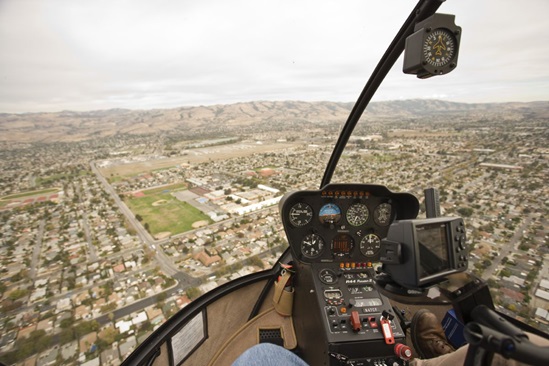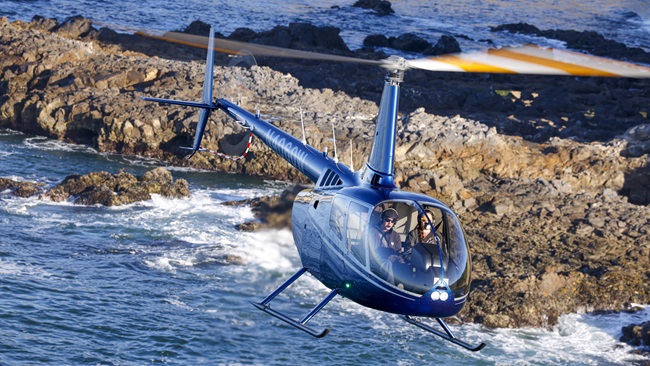Proficiency: More than a bumpy ride
Unique considerations with helicopters and turbulence
By Markus Lavenson
Helicopters have the unique ability to sustain flight without requiring airspeed. However, the ability to fly slowly and even hover presents special considerations regarding turbulence.

Photography above by Jeremy Averett, below right by Chris Rose
 While all aircraft are subject to adverse effects of turbulent air, particularly downdrafts and wind shear near the ground, there are specific aspects a helicopter pilot should consider. Turbulence can make for an uncomfortable ride in any aircraft, but it’s the sudden changes to vertical rate and airspeed that are critical to safe flight in a helicopter. Turbulence can adversely affect performance, induce vortex ring state (VRS), and cause loss of tail rotor effectiveness.
While all aircraft are subject to adverse effects of turbulent air, particularly downdrafts and wind shear near the ground, there are specific aspects a helicopter pilot should consider. Turbulence can make for an uncomfortable ride in any aircraft, but it’s the sudden changes to vertical rate and airspeed that are critical to safe flight in a helicopter. Turbulence can adversely affect performance, induce vortex ring state (VRS), and cause loss of tail rotor effectiveness.
Consider a heavily loaded helicopter hovering in a high density altitude condition at or near maximum power in a 25-knot wind. A decrease in wind speed below effective translational lift (16 to 24 knots) will cause the aircraft to sink unless more power is available. In effective translational lift, increased airspeed or wind makes lift generated by the rotor disk more effective. One way to think of performance is related to airspeed; the further below best rate of climb airspeed (VY), the less efficient the rotor system and the greater the power requirement—with a significant dropoff in performance just below effective translational lift.
Helicopters also require slightly more power hovering in a wind just below effective translational lift than in no wind, as the main rotor disc is tilted forward slightly, sacrificing part of the vertical lifting force for enough forward horizontal thrust to hold position against the wind. Above effective translational lift, such as when hovering in a 25-knot wind, the rotor system has less rotor-system-induced downwash, becoming much more efficient. A change of wind speed or direction can effectively lower airspeed during the beginning of a takeoff or toward the end of an approach, degrading performance.
The goal during takeoff is to transition to an airspeed that can be maintained above effective translational lift accounting for gusts, and during landing to watch for sudden decreases in airspeed and increases in descent rate. Early actions reversing adverse trends are better than reactions, especially in high density altitude conditions, and when flying heavy or marginally powered helicopters. The ramifications of turbulence often are more critical during landing than for takeoff, as the helicopter is already in a descent and converging with the ground.
As the aircraft slows to 10 knots, one critical aspect is the avoidance of vortex ring state. VRS is basically a condition where the helicopter is settling in its own downwash, with an associated high descent rate. VRS requires these three parameters to be present—airspeed of 10 knots or less, at least 20 percent power, and at least a 300-fpm descent rate. It’s important to understand the aircraft doesn’t actually need to be descending, but just experiencing an upflow of air through the rotor system of at least 300 fpm (3.5 mph), as though in a descent. If a helicopter is hovering along a steep ridgeline and suddenly encounters an updraft of 300 fpm, it is now experiencing an upflow of air that could cause VRS.
While VRS is more common during descent for landing, it can be a factor during takeoffs. A pilot making a takeoff from a pinnacle, rooftop, or steep ridgeline could be susceptible to entering an updraft condition while airspeed is less than 10 knots or even while in a hover. An effective response for escaping VRS is to trade altitude for airspeed with forward cyclic or use the Vuichard Recovery Technique: right lateral cyclic with left pedal (counterclockwise rotor system). As long as the helicopter is clear of obstacles laterally, the Vuichard procedure results in minimal altitude loss. During slow flight, a pilot should be prepared for VRS, having the helicopter in a position for a VRS recovery (see “Proficiency and Efficiency: Escape Plan,” February 2020 AOPA Pilot).
During landing, a pilot may be making a safe approach where two of the VRS conditions are met, when a sudden change in airflow provides the third. A sudden updraft; gust with a tailwind component; or downdraft that descends the aircraft so that when it exits the downdraft, the relative descent rate has increased more than 300 fpm all can provide the third VRS requirement.
During an approach, determine if the turbulence is mostly horizontal wind gusts—denoted by fluctuating airspeed—or mostly vertical instability, denoted by fluctuating vertical speed. When vertical speed is not stable, select a stable airspeed well above 10 knots; and when airspeed is not stable, select a stable vertical speed less than 300 fpm. This is to prevent at least one VRS condition from existing at any one time.
Another aspect to be considered is loss of tail rotor effectiveness. Many helicopters have a critical wind azimuth chart in the rotorcraft flight manual depicting the range of wind direction that can cause the tail rotor to lose its ability to control yaw. Just as the main rotor can be susceptible to VRS, the tail rotor can as well. The critical wind azimuth chart usually has a correlation of density altitude to gross weight, where a specific wind direction can result in tail rotor VRS and subsequent loss of tail rotor effectiveness. This condition is more susceptible at higher density altitudes and gross weights because the helicopter already requires more tail rotor pitch to control yaw. With an already high pitch setting across the tail rotor blade airfoil, it is closer to the critical angle of attack and more susceptible to loss of tail rotor effectiveness. When the helicopter is not in coordinated forward flight, the pilot must be aware of changes in wind direction and speed, and adjust the aircraft heading so the tail rotor is never within the danger zone on the critical wind azimuth chart.
Flying helicopters at slow speed safely requires a pilot to anticipate varying airflow conditions; to recognize when those conditions are beginning to affect the aircraft; and then to provide quick corrective action.
Cruise flight
Helicopters do not have a published maneuvering airspeed (VA) or turbulence penetration speed (VB), and while helicopters tend to be less susceptible than airplanes to the effects of turbulence in cruise flight, there remain aspects the pilot should consider.
Despite best efforts in avoidance, turbulence can be encountered in flight and the pilot must mitigate the situation by controlling the helicopter, minimizing the effect of turbulence, and possibly exiting the condition. When encountering turbulence in a helicopter, most pilots will slow down. While decreasing airspeed helps avoid VNE during a gust with a headwind component, it is equally important to decrease the pitch and angle of attack of the main rotor blades. A sudden updraft will increase the angle of attack of the relative wind over the blade airfoil, and if it’s enough to reach the critical angle of attack, that part of the main rotor blade will stall.
This is often seen during mountain flying at relatively high altitudes. As the helicopter flies higher, the air is less dense and therefore the helicopter needs more collective pitch to maintain the same amount of lift. This is why a helicopter’s VNE will decrease with altitude, effectively limiting the angle of attack of the main rotor blades so the critical angle of attack is not exceeded. However, a sudden updraft or gust can change all that by causing an area of the rotor disc to stall.
Many years ago, traversing New Mexico’s Black Range mountains in an MBB Bo 105 helicopter, we encountered significant turbulence. Despite reducing power and slowing down, a violent updraft caused the helicopter to abruptly pitch nose up. Pushing forward cyclic had no effect and the helicopter would have become inverted had the company instructor not lowered the collective. As collective was reduced the helicopter regained a level pitch attitude, and I learned a valuable lesson that day—without the excitement of going inverted. The sudden updraft had caused retreating blade stall, which because of gyroscopic precession caused the helicopter to pitch up. The only corrective action was to immediately lower collective, reducing the pitch and alleviating the stall condition.
When in cruise flight during turbulent conditions, the most hazardous changes are gusts with a headwind component and updrafts. A headwind gust will reduce the airspeed over the retreating rotor blade and increase the angle of attack, possibly to the point of a stall. An updraft will increase the angle of attack on all the rotor blades throughout the rotor disc area, with the retreating blade more susceptible to a stall—because its airspeed is slower and compensating angle of attack greater than the advancing blade.
The best way to fly a helicopter in turbulence isn’t much different than an airplane, in that the pilot should slow down and maintain a constant pitch attitude. I recommend the helicopter be slowed well below VNE yet above best rate of climb speed, maintaining a level pitch attitude. Slight adjustments to the collective and power can be made to hold altitude or a safe block altitude, and slight adjustments to fore-aft cyclic pitch attitude can be made to control airspeed. Despite momentary effects of turbulence, maintaining attitude and power will keep the helicopter within safe parameters, resulting in smoother flight that is less taxing on the aircraft and occupants.
Markus Lavenson is a helicopter pilot currently flying as captain in the Sikorsky S92 and AgustaWestland AW139.


